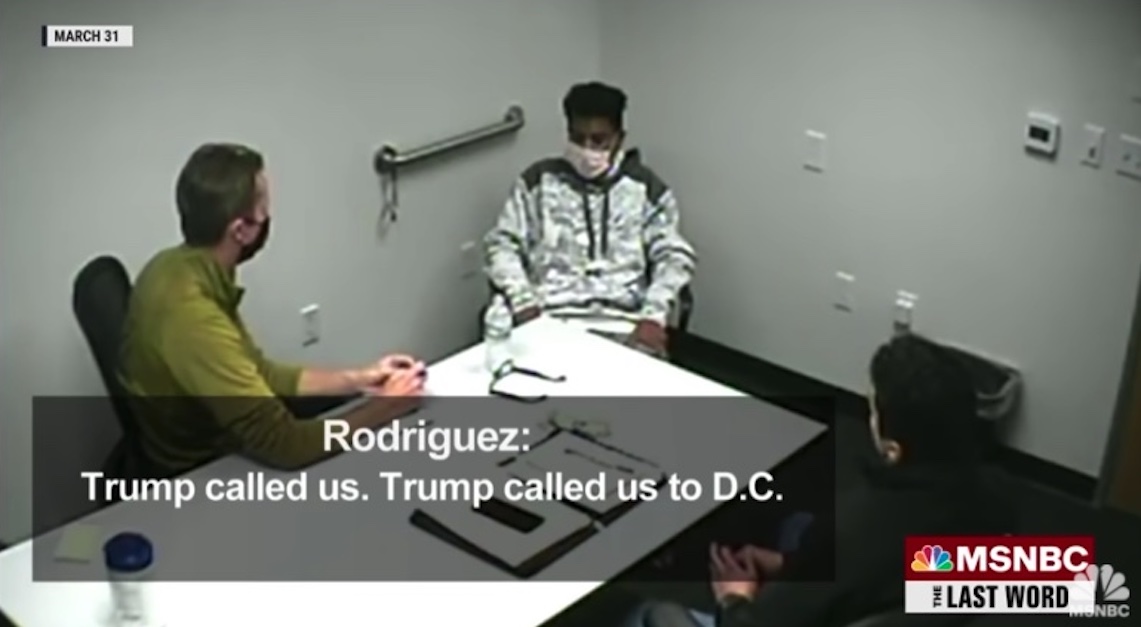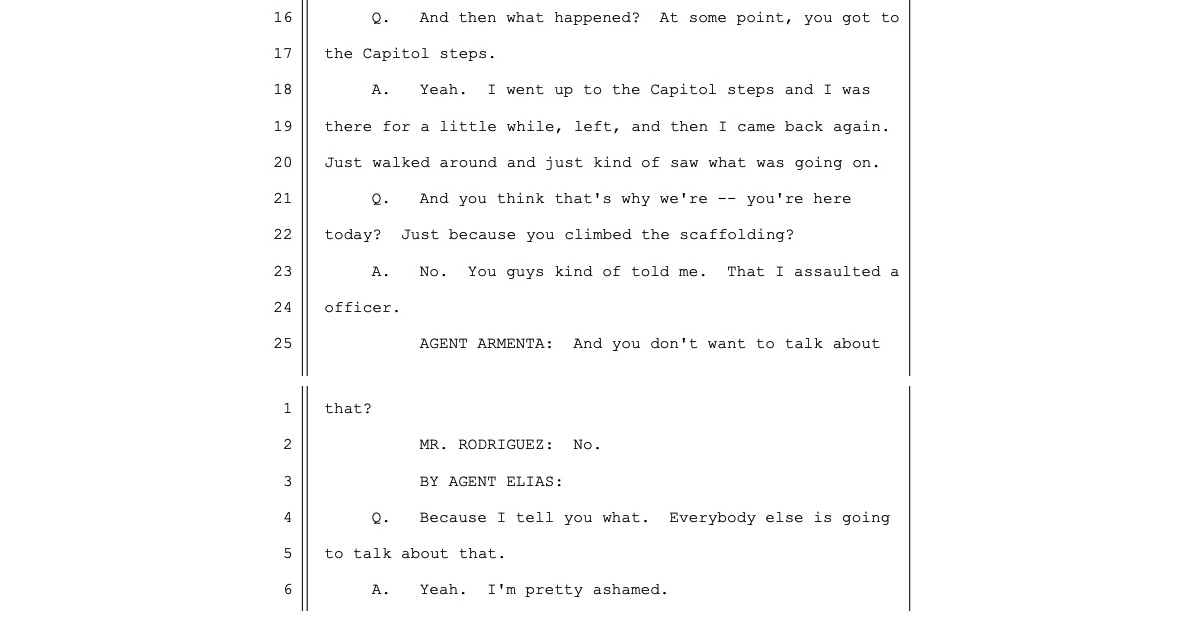
Image via MSNBC/YouTube screengrab.
The California man accused of Tasing a police officer at the Capitol on Jan. 6 will not be allowed to exclude parts of an interview with federal investigators in which he appears to confess to the attack.
Daniel Rodriguez, 39, is charged with assaulting Metropolitan Police Department officer Michael Fanone as supporters of Donald Trump overran the U.S. Capitol in an attempt to stop the Electoral College certification of Joe Biden‘s win in the 2020 presidential election.
Fanone was dragged down the Capitol steps and “beaten with pipes and poles, tear-gassed and stun-gunned,” all while pleading for his life and telling the mob that he had kids. He suffered a mild heart attack allegedly triggered by Rodriguez’s stun gun. He survived and eventually testified before Congress about his experience.
The crux of Rodriguez’s motion to suppress was a portion of a March 31 interview by federal agents Nate Elias and Enrique Armenta. During that interview, Rodriguez appears to have admitted to the assault.
“[Y]ou think that’s why we’re — you’re here today? Just because you climbed the scaffolding?” Elias asked Rodriguez.
“No,” Rodriguez responded. “You guys kind of told me. That I assaulted a officer.”
“And you don’t want to talk about that?” Armenta said, according to the transcript.
“No,” Rodriguez said, according to the first — and contested — transcript of the conversation.
Elias then said: “Because I tell you want. Everybody else is going to talk about that.”
“Yeah. I’m pretty ashamed,” Rodriguez said.

Transcript via court filing
Rodriguez’s lawyers argued that he had “unambiguously and unequivocally invoked his right to silence” at this point in the interview and at that questioning should have ended consistent with the defendant’s constitutional rights.
However, as U.S. District Judge Amy Berman Jackson discussed in detail at Wednesday’s hearing, the transcript doesn’t tell the whole story.
“I have watched the video over well over 50 times, probably more than 100 times,” Jackson said. “I have never heard the word no.”
Noting that she had a program installed on her laptop so that she could hear the audio more clearly, Jackson said that an “n” sound from Rodriguez and a shake of the head — “and not a very vigorous one at that,” she observed — did not amount to an unambiguous and unequivocal assertion of the defendant’s Miranda rights.
Federal prosecutors filed court papers prior to the hearing which teed up the judge’s analysis. They asserted that the video showed the defendant making an unintelligible “n” sound as the next question came rolling his way.
Jackson issued her ruling after a painstaking, second-by-second review of this part of the interview, which was also played at the hearing. Jackson narrated each statement, describing details that weren’t captured by the transcript, such as head shakes, crosstalk, and the pauses — or lack thereof — between the questions and answers.
“While you can see the defendant shake his head before Agent Elias starts to speak, Agent Elias has already begun his comments when you can hear the defendant start to say something at the same time,” Jackson said. “You hear a sound, the government now identifies it as something that begins with ‘n,’ but what he is saying and what Elias is saying at 7:55:03 overlap. They overlap again at 7:55:09,” Jackson added, citing the timestamps on the video.
“Only nine seconds at the most elapsed between the end of Agent Elias saying ‘You want to talk about that’ and the defendant saying he is ashamed,” Jackson noted.
Jackson, a Barack Obama appointee, also went through an extensive analysis of Supreme Court jurisprudence on the landmark Miranda v. Arizona case, the benchmark in determining a defendant’s Fifth Amendment protections against self-incrimination. She also noted multiple examples of Rodriguez shaking his head in a manner similar to what he did during the nine seconds at issue.
“There is considerable ambiguity over what he’s feeling negative about,” Jackson said. “It was entirely reasonable to draw the impression that what he was communicating was ‘I am distressed about talking about this, I can’t believe I have gotten myself into this position, what have I done, I am so ashamed,’ as opposed to ‘I do not want to answer any more questions.'”
“Does Mr. Rodriguez like to talk about this?” Jackson continued. “He doesn’t. Is he proud about what he’s accused of? He isn’t. But does he invoke his right to remain silent? It’s ambiguous at best.”
Jackson also said that Rodriguez “shakes his head the same way when he gets to the topic of the Capitol steps, and not in response to the question.”
Jackson also pointed to other parts of the interview in which Rodriguez appears to have clearly asserted himself, and concluded that Rodriguez could have stopped the questioning had he so desired.
“The defendant himself is perfectly capable of saying — and did say — I don’t really want to answer that,” she said, referring to a point later in the interview. “He was assertive and he pressed his point. But back on page 37, what he did say . . . was ‘I’m pretty ashamed.’ What he communicated then [was] embarrassment, discomfort, shame.”
“He waived his Miranda rights in writing,” Jackson also said, noting that she ruled that waiver was knowing and voluntary. “This was not a novel procedure for him. He volunteered ‘My lawyers usually tell me not to talk.’ So he knew his rights.”
You can read the transcript of the interview between Rodriguez and agents Elias and Armenta below.
[Image via MSNBC/YouTube screengrab]